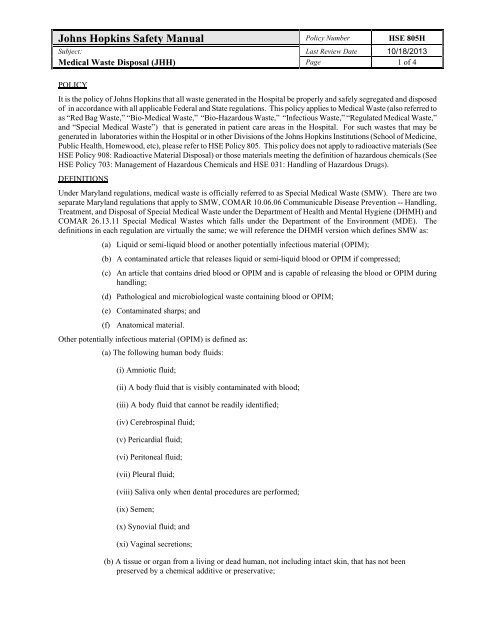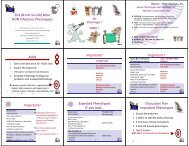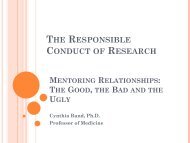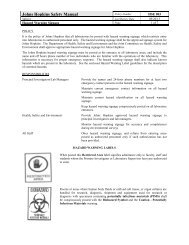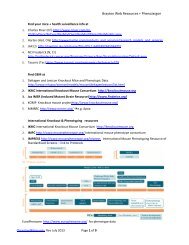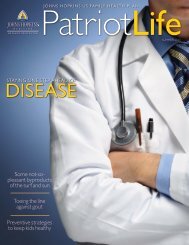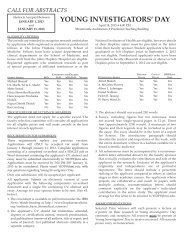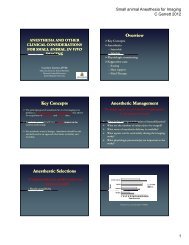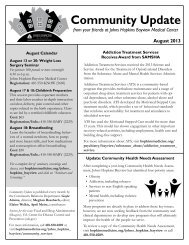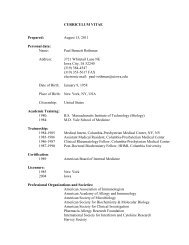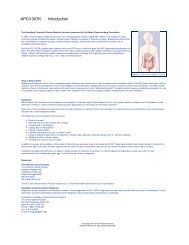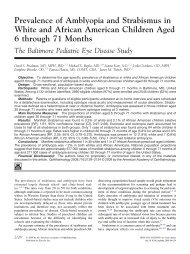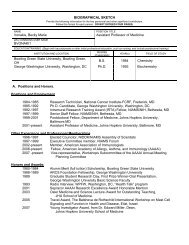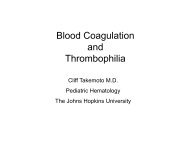Medical Waste Disposal (JHH) - HSE805H - Johns Hopkins Medical ...
Medical Waste Disposal (JHH) - HSE805H - Johns Hopkins Medical ...
Medical Waste Disposal (JHH) - HSE805H - Johns Hopkins Medical ...
You also want an ePaper? Increase the reach of your titles
YUMPU automatically turns print PDFs into web optimized ePapers that Google loves.
<strong>Johns</strong> <strong>Hopkins</strong> Safety Manual Policy Number HSE 805H<br />
Subject: Last Review Date 10/18/2013<br />
<strong>Medical</strong> <strong>Waste</strong> <strong>Disposal</strong> (<strong>JHH</strong>) Page 1 of 4<br />
POLICY<br />
It is the policy of <strong>Johns</strong> <strong>Hopkins</strong> that all waste generated in the Hospital be properly and safely segregated and disposed<br />
of in accordance with all applicable Federal and State regulations. This policy applies to <strong>Medical</strong> <strong>Waste</strong> (also referred to<br />
as “Red Bag <strong>Waste</strong>,” “Bio-<strong>Medical</strong> <strong>Waste</strong>,” “Bio-Hazardous <strong>Waste</strong>,” “Infectious <strong>Waste</strong>,” “Regulated <strong>Medical</strong> <strong>Waste</strong>,”<br />
and “Special <strong>Medical</strong> <strong>Waste</strong>”) that is generated in patient care areas in the Hospital. For such wastes that may be<br />
generated in laboratories within the Hospital or in other Divisions of the <strong>Johns</strong> <strong>Hopkins</strong> Institutions (School of Medicine,<br />
Public Health, Homewood, etc), please refer to HSE Policy 805. This policy does not apply to radioactive materials (See<br />
HSE Policy 908: Radioactive Material <strong>Disposal</strong>) or those materials meeting the definition of hazardous chemicals (See<br />
HSE Policy 703: Management of Hazardous Chemicals and HSE 031: Handling of Hazardous Drugs).<br />
DEFINITIONS<br />
Under Maryland regulations, medical waste is officially referred to as Special <strong>Medical</strong> <strong>Waste</strong> (SMW). There are two<br />
separate Maryland regulations that apply to SMW, COMAR 10.06.06 Communicable Disease Prevention -- Handling,<br />
Treatment, and <strong>Disposal</strong> of Special <strong>Medical</strong> <strong>Waste</strong> under the Department of Health and Mental Hygiene (DHMH) and<br />
COMAR 26.13.11 Special <strong>Medical</strong> <strong>Waste</strong>s which falls under the Department of the Environment (MDE). The<br />
definitions in each regulation are virtually the same; we will reference the DHMH version which defines SMW as:<br />
(a) Liquid or semi-liquid blood or another potentially infectious material (OPIM);<br />
(b) A contaminated article that releases liquid or semi-liquid blood or OPIM if compressed;<br />
(c) An article that contains dried blood or OPIM and is capable of releasing the blood or OPIM during<br />
handling;<br />
(d) Pathological and microbiological waste containing blood or OPIM;<br />
(e) Contaminated sharps; and<br />
(f) Anatomical material.<br />
Other potentially infectious material (OPIM) is defined as:<br />
(a) The following human body fluids:<br />
(i) Amniotic fluid;<br />
(ii) A body fluid that is visibly contaminated with blood;<br />
(iii) A body fluid that cannot be readily identified;<br />
(iv) Cerebrospinal fluid;<br />
(v) Pericardial fluid;<br />
(vi) Peritoneal fluid;<br />
(vii) Pleural fluid;<br />
(viii) Saliva only when dental procedures are performed;<br />
(ix) Semen;<br />
(x) Synovial fluid; and<br />
(xi) Vaginal secretions;<br />
(b) A tissue or organ from a living or dead human, not including intact skin, that has not been<br />
preserved by a chemical additive or preservative;
<strong>Johns</strong> <strong>Hopkins</strong> Safety Manual Policy Number HSE 805H<br />
Subject: Last Review Date 10/18/2013<br />
<strong>Medical</strong> <strong>Waste</strong> <strong>Disposal</strong> (<strong>JHH</strong>) Page 2 of 4<br />
(c) The following human immunodeficiency virus, hepatitis B virus, or hepatitis C virus related items:<br />
(i) HIV containing cell, tissue, or organ cultures;<br />
(ii) HIV, Hepatitis B, or Hepatitis C containing media or other solutions; and<br />
(iii) Blood, organs, or other tissues; and<br />
(d) Microbiological laboratory waste.<br />
Please note that the mere presence of blood or OPIM on an article does not make it <strong>Medical</strong> <strong>Waste</strong>. An article must be<br />
contaminated with blood or OPIM and be capable of releasing it during handling. If you are unsure about whether an<br />
article is so contaminated that it will release blood or OPIM during handling, be conservative and dispose of it as<br />
<strong>Medical</strong> <strong>Waste</strong>.<br />
MEDICAL WASTE DISPOSAL:<br />
Articles or materials meeting the definition of <strong>Medical</strong> <strong>Waste</strong> as enumerated above shall be disposed of in approved red<br />
bags. The containers in which the red bags are placed must have lids, and the containers must be kept closed except<br />
when in use. The only exceptions are in Operating Rooms where the red bag is disposed of after each case. . Do not<br />
overfill or compress the contents of the bag. When full, the bag must be sealed securely enough to prevent any leakage<br />
of contaminated items during handling.<br />
SHARPS DISPOSAL:<br />
Definition/ Guidelines:<br />
Sharps are any material that can puncture or cut human skin or a red trash bag (such as syringes with needles,<br />
needles alone, small glass objects, scalpel blades, Pasteur pipettes and razor blades). ALL sharps, other than those<br />
in their original, intact packaging, are considered to be <strong>Medical</strong> <strong>Waste</strong> and must be discarded into an approved<br />
sharps container. Needles and other sharps are never to be discarded directly into a red bag, red bag-lined biohazard<br />
box or into other waste streams with one exception. Drug delivery devices such as syringes or IV bags with attached<br />
needles that were used for administering chemotherapy agents or other hazardous drugs, can be directly discarded<br />
into yellow ChemoMax containers, provide they contain only trace amounts of the material in the syringe or IV bag.<br />
See HSE Policy 031: Handling of Hazardous Drugs and the <strong>Waste</strong> Segregation Chart at the end of this policy for<br />
further information.<br />
All needles and sharps must be discarded directly into approved sharps disposal containers. An approved sharps<br />
container shall be placed in all patient rooms (except psychiatric and certain pediatric rooms), medication rooms,<br />
soiled utility areas, and all other areas where sharps are utilized. Containers for the disposal of sharps shall be<br />
limited to those approved by the Clinical Products Value Analysis Committee. All sharps containers must be<br />
appropriately sealed prior to disposal to prevent spillage.<br />
Guidelines for the safe handling of sharps:<br />
1. Sharps are never to be discarded directly into the regular trash.<br />
2. Needles are not to be clipped or bent.<br />
3. Needles are not to be recapped by a “two-handed method”.<br />
4. The user shall be responsible for proper sharps disposal. Sharps shall not be left on furniture, equipment, or<br />
counter tops.<br />
5. Sharps should never be carried in pockets. Needles used at a distance from a disposal container shall be<br />
transported safely to the disposal area by using a puncture-resistant basin or similar container.<br />
6. <strong>Disposal</strong> containers shall not be overfilled. Filled containers shall be properly sealed and disposed of in<br />
receptacles lined with a red bag.<br />
7. Sharps disposal containers are puncture resistant, not puncture proof. Filled containers are to be handled with<br />
caution; sharps may penetrate under certain conditions.
<strong>Johns</strong> <strong>Hopkins</strong> Safety Manual Policy Number HSE 805H<br />
Subject: Last Review Date 10/18/2013<br />
<strong>Medical</strong> <strong>Waste</strong> <strong>Disposal</strong> (<strong>JHH</strong>) Page 3 of 4<br />
Guidelines for utilization of approved sharps containers:<br />
1. Syringe units with needles permanently attached, needles alone, and all other sharps are discarded directly into<br />
the container.<br />
2. The container should be placed in all areas where sharps are utilized.<br />
3. The lid on the container is to be left off until the container is ready for disposal. Do not close after each use.<br />
When sharps reach maximum fill level designated on container, secure lid over opening by screwing cap until<br />
tight.<br />
4. Sharps used at a distance from the disposal container are to be carried safely to the disposal container by use of<br />
a puncture-resistant basin or other similar container.<br />
Guidelines for disposal of sharps containers:<br />
For containers other than the Biosystems re-usable ones.<br />
1. Sharps containers are to be inspected prior to use to avoid overfilling or injury.<br />
2. Filled containers are closed as appropriate and replaced.<br />
3. All filled containers, other than those used for the disposal of sharps contaminated with radioactive materials,<br />
are considered to be infectious waste and should, after being properly capped or closed, be placed in receptacles<br />
lined with red bags. Containers used for the disposal of “hot” sharps must be disposed of as radioactive waste.<br />
4. Handle with caution. Sharps containers are puncture resistant, not puncture proof.<br />
Utilization of Approved Sharps Containers (other than Biosystems):<br />
Six-Quart or Ten-Quart Plastic Container: <strong>JHH</strong> PPM # 3269<br />
1. The lid on the six-quart and ten-quart container shall be left open until the container is ready for disposal.<br />
Do not close after each use. When sharps reach maximum fill level designated on container, secure lid over<br />
opening by screwing cap until tight.<br />
2. Secured sharps containers shall be discarded as medical waste in red bags or approved red bag-lined<br />
Biohazard boxes<br />
Sage Sharps Container for use in areas accessed by patient and visitors:<br />
<strong>JHH</strong> PPM# 24387 (3 gallon), , PPM#46039 (4 gallon), # 24386 (5 quart)<br />
1. Insert sharps horizontally and lift tray to assure complete disposal.<br />
2. When the lid indicates FULL, lock by depressing top two tabs.<br />
3. Discard as medical waste in red bags.<br />
5 oz. Phlebotomy Container: <strong>JHH</strong> PPM# 20400<br />
1. Needles are unscrewed directly into the container.<br />
2. Once the needle has been removed, syringes and needle caps may be discarded directly into the red bag<br />
receptacle designated for medical waste.<br />
Other Approved Sharps Containers<br />
1. PPM# 4768 1 quart<br />
2. PPM# 1975 2 gallon<br />
3. PPM# 6134 18 gallon Sage floor model<br />
4. PPM# 3704 8 gallon Sage floor model<br />
5. PPM#25115 3 gallon Sage red rotor top<br />
Needlesticks and Exposure to Biohazards<br />
All needlesticks and exposures to sharps must be reported immediately by calling the Needlestick Hotline 5-STIX<br />
(955-7849) for the East Baltimore Campus. Employees on the Bayview campus can either call 5-STIX or Bayview<br />
Employee Health at 0-0477 (for BBP exposures only). An incident report must be filed. Specific details concerning<br />
the type of sharp and the actual occurrence should be listed to identify practices or types of equipment which may<br />
need to be modified.
<strong>Johns</strong> <strong>Hopkins</strong> Safety Manual Policy Number HSE 805H<br />
Subject: Last Review Date 10/18/2013<br />
<strong>Medical</strong> <strong>Waste</strong> <strong>Disposal</strong> (<strong>JHH</strong>) Page 4 of 4<br />
Problems involving a particular type of sharp or procedure, which may cause exposures to blood-borne pathogens,<br />
should be brought to the attention of Health, Safety and Environment (5-5918).<br />
REFERENCES<br />
Code of Maryland Regulations 10.06.06: Communicable Disease Prevention - Handling, Treatment and <strong>Disposal</strong><br />
of Special <strong>Medical</strong> <strong>Waste</strong><br />
Code of Maryland Regulations 26.13.11: Special <strong>Medical</strong> <strong>Waste</strong>s<br />
29 CFR 1910.1030 OSHA Bloodborne Pathogen Standard<br />
<strong>Johns</strong> <strong>Hopkins</strong> Safety Manual: Bloodborne Pathogens Exposure Control Program, HSE 501<br />
<strong>Johns</strong> <strong>Hopkins</strong> Safety Manual: Occupational Injury Management, HSE 005<br />
RESPONSIBILITIES<br />
All Patient Care Staff<br />
Departmental Management<br />
Clinical Products Value Analysis Committee<br />
Health, Safety and Environment<br />
Properly segregate and dispose of all materials.<br />
Enforce this policy.<br />
Approve variety of sharps containers available.<br />
Monitor compliance with policy during environmental surveys.<br />
Provide direction regarding handling and disposal of medical waste.<br />
Investigate Bloodborne Pathogen exposures.<br />
Materials Management<br />
Maintain supply of approved sharps containers, red bags, and other<br />
waste containers.<br />
REVIEW CYCLE<br />
Annually


